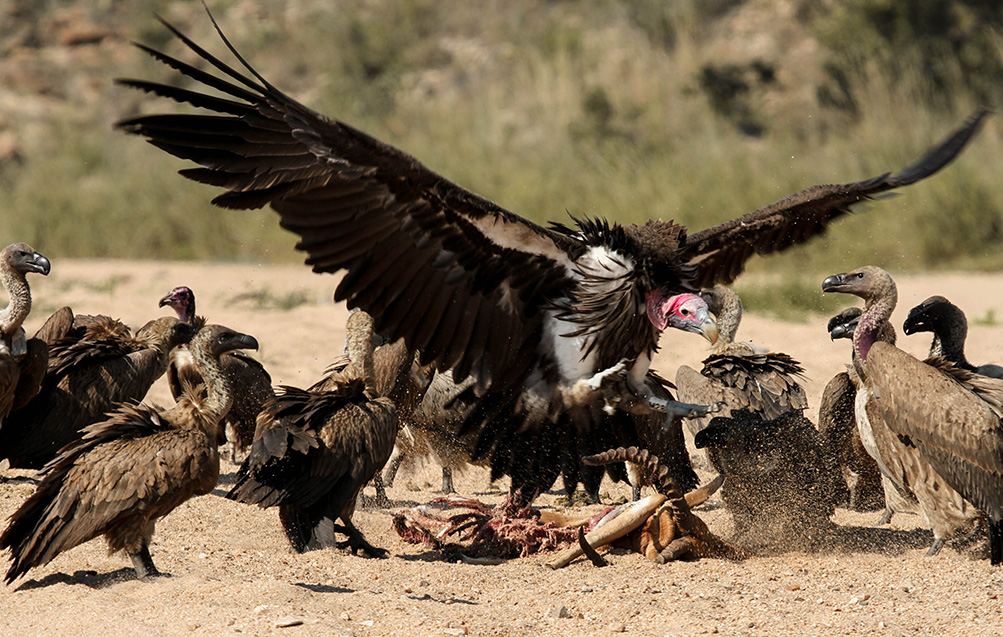The lodge has been built to the most stringent eco-management criteria in South Africa, audited by Kruger National Park and DEAT (Department of Environment and Tourism) on a bi-annual basis.
Conservation in the Kruger National Park is the responsibility of SANParks supported by the Jock management and Jock Environmental Monitoring Unit (JEMU). Jock Safari Lodge contributes to conservation by paying a percentage of all turnover generated by tourism to SANParks. What makes this arrangement unique is that every guest staying at the lodge contributes directly to conservation not only in the Kruger but in other national parks.
Jock Safari Lodge has a 100% commitment to maintaining a low-impact footprint. Over and above the concession fees paid annually, the CALEO Foundation contributes to several conservation projects, in line with our mission to preserve and protect wildlife and wilderness areas.
Savanna Vulture project
The Greater Kruger National Park is home to breeding populations of five vulture species, which makes it the perfect place for studying and monitoring these birds. These vultures, like the lappet-faced vulture (Torgos tracheliotus) and the Cape vulture (Gyps coprotheres), are either endangered or critically endangered.
A decade ago, the status of vultures in the Greater Kruger National Park was poorly understood. The Endangered Wildlife Trust and the Hawk Conservancy Trust (UK) recognised this knowledge gap and in 2007, they registered the three-year Savanna Vulture Project with SANParks to assess population status, breeding success and survival of tree-nesting vulture species in the Greater Kruger National Park.
The results from the Savanna Vulture Project have greatly improved our general understanding of what is needed to conserve vultures in the Greater Kruger National Park. These findings have also informed the Multi-species Action Plan for Africa-Eurasian Vultures, which will guide conservation actions for these birds in Southern Africa. Today, work continues on various aspects of vulture biology in the Lowveld.

The Black Rhino Guardian Programme
The black rhino has a long and tragic history of persecution in Africa. The black rhino (Diceros bicornis) was once widespread in Africa, however during the second half of the 20th century, 97% of the population was lost, and relentless poaching threatens what remains. SANParks has implemented a Black Rhinoceros Guardian Programme in the Kruger National Park to monitor and manage South Africa’s largest surviving population and to provide it with the best protection possible.
Early in the 1970s, SANParks began reintroducing black rhino into the Kruger and in 2008, the population was estimated to be at 620. Unfortunately, this coincided with the start of a dramatic increase in poaching and, when a dedicated rhino census was carried out five years later, the population had dwindled to 427 animals.
This drop in numbers raised significant concerns about the future of the species. As a result, in 2016 SANParks launched the Black Rhinoceros Guardian Programme, the main aims of which are to intensify monitoring of the animals throughout the park, increase biological management and veterinary care, and prioritise security responses. Because black rhino are difficult to monitor across vast areas, a range of techniques and technologies are employed including aerial censuses. This gages the estimated total size of the population on an annual basis, in addition to the aerial counts, 25 black rhino females were fitted with satellite-tracking foot collars. The collar data help the programme understand how black rhino move within their home ranges, at different times of the year, between day and night, and across environmental gradients. Generous support from sponsors, including Jock Safari Lodge, assisted this initiative.

Lion Research
Today, fewer than 35 000 lion (Panthera leo) remain in the wild, about 3 000 of them in South Africa, the Kruger National Park has about 1 700. In some other areas lions have a torrid time, hunters pursue them, especially if they have a beautiful mane. Poachers hunt them. To Asian medicine men, lion bone is as good as tiger bone for healing properties.
In the 1990s State veterinarians discovered bovine tuberculosis (TB) in lions, contracted mostly through their prey. It was a cause for concern. After several different approaches were conducted to test for TB, researchers started working on diagnostic one-off tests that could help field biologists. The only verified test is the skin test. Researchers catch a lion and start the skin test and after they’ve collected all samples, the lions are kept in the mobile boma and the test results are completed three days later.
Researchers found that TB did not influence the size of lion’s home range – 50 to 900km2 in the Kruger – or the length of time that males have tenure of a pride – between 1.8 to 4.5 years. Once researchers accounted for food availability, they could find no evidence that TB is causing trouble for lion populations.
Additional Projects have included: demographic study on lion, southern ground hornbill, wild dog and martial eagle research.
